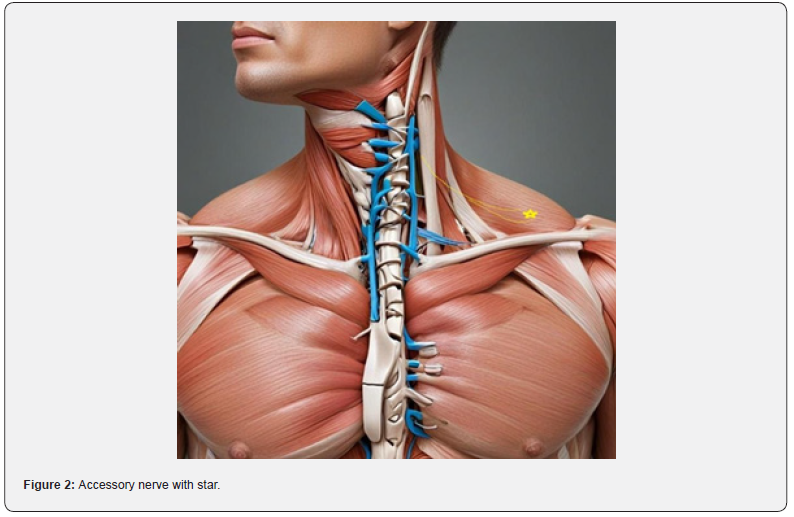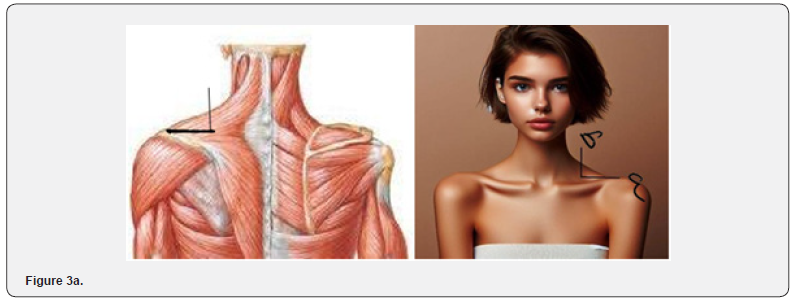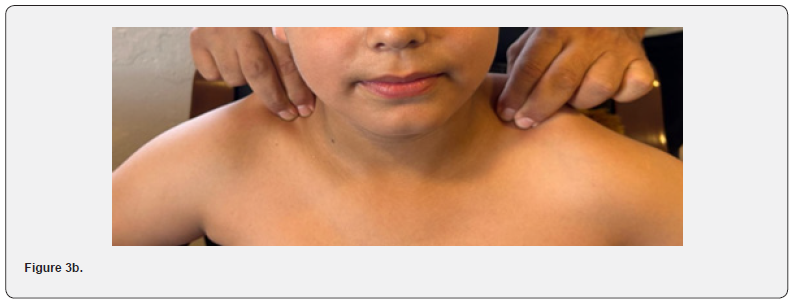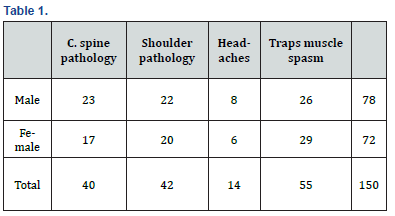Jouni Test in Trapezius Muscle
Haidar Jouni*
Islamic University of Lebanon, faculty of health, Orthopedic Department, Jabal Amel hospital, Tyr, Lebanon
Submission: June 30, 2024; Published: July 10, 2024
*Corresponding author: Haidar Jouni, Islamic University of Lebanon, faculty of health, Orthopedic Department, Jabal Amel hospital, Tyr, Lebanon
How to cite this article: Haidar J. Jouni Test in Trapezius Muscle. Ortho & Rheum Open Access J. 2024; 23(4): 556118. DOI: 10.19080/OROAJ.2024.23.556118
Abstract
Neck pain is a condition that affects most people, but the causes are many and different from person to another. It is pain that extends from the occipital region of the head to the middle of the back and includes both shoulders in some cases and may extend towards the fingers or be associated with severe headaches pain. To distinguish cases of acute spasm, we used a special examination test-Jouni test, as it showed positive signs in cases of severe straps muscle spasm. The study was done on 150 cases Suffering from Limited mobility, decreased range of motion or muscle weakness (you may not be able to shrug your shoulders or raise your arm). Neck and shoulder pain and stiffness, ranging from shoulder pain to rotator cuff injury, bursitis, swelling tenderness shoulder region, and traps muscle spasm.
Introduction
The trapezius muscle, or as it is often called in many countries, traps muscle, is a large surface muscle of the upper back that resembles a trapezoid. It extends from the external projection of the occipital bone -external occipital protuberance -to the lower thoracic vertebrae and laterally to the scapular spine (Figure 1). The trapezius has three sections, the superior, middle, and inferior fibers, and each segment plays a role in specific movements of the neck and shoulders. Upper fibers elevate the shoulder, while Lower fibers depress the shoulder, and Middle fibers brace back (retraction) of shoulder. Traps muscle helps you to move your neck, head and shoulders. Muscle strains injury can affect the traps muscle and cause pain and decrease its mobility.
The anterior branches of the C3 and C4 spinal nerves innervate the sensory functions of the trapezius muscle. While the spinal accessory nerve (cranial nerve XI) innervates the motor function of the trapezius Branches of XI cranial nerve perforate both sternocleidomastoid and the trapezius muscle [1]. It passes, posterior to the sternocleidomastoid edge of the muscle itself and about 4 to 9 centimeters below the apex of the mastoid process. Another point is located in the trapezius muscle, about 2 to 9 centimeters above the clavicula towards the acromion-clavicular joint, at the junction between middle and lower muscle fiber [2-4] (Figure 2).
Theres some signs and symptoms that affect the traps muscle, these signs can be found daily, especially among young people and those who use smart devices and drive long distances, which causes severe traps muscle spasm.
Material and Methods
The study was conducted on a sample of patients 150 cases of patients at Jouni clinic (Table 1). Their ages ranged between 20-50 years (table 3), males and females, and they suffered from health problems in the neck and shoulders. The study was based on medical history, clinical examination, and x-rays radiographs of cervical spine and shoulder, as well as MRI - magnetic resonance imaging -for some cases, and nerve EMG. During the study, cases suffering from shoulder disc were excluded patients with clinical signs of herniated bulge or disc, rotator cuff injury, headaches, and the group with straps muscle spasm was retained (Table 1). The required examination -Jouni test-was performed, and it was found that the pain had disappeared when the examination was performed.
How to conduct the examination Jouni test
The examination is done by grabbing the straps muscle at the junction of traps muscle with acromio- clavicular joint 3-4 cm medial to the junction (a) and 2-3 cm below the border of the descending fibers of traps muscle (b), a and b must be at right angle (Figure 3a). We place the thumb from the back, and we place 3rd and 4th fingers from the front of the traps muscle, and we squeeze the muscle at this point (Figure 3b). Then we ask the patient to move the head and neck towards the right and left, forward and backward, and we will see that he moves freely without pain, as if the muscle was not spasmodic, and this point is where the nerve enters the muscle.




Results
The study was conducted on 150 patients from different age groups, ranging in age from 20 to 50 years and from both sexes (Tables 1-3), who suffer from different sign and symptoms ‘in the neck, head, and shoulders, in other words, pathological conditions that have a common denominator, which is pain or spasm in the neck muscle, and the following can be concluded:



After the physical, clinical, and radiological (x-ray or MRI), and EMG examination, the cases were diagnosed, and it became clear that the spasm could be related to other conditions that it has in common, such as neck disc (40 cases), shoulder pain (42 cases), as well as head pain (14 cases), which was the result of malnutrition, as hypo or hyper in blood sugar, iron level, or blood pressure. All these cases showed pain in the neck muscle, and through Jouni Test it was negative when examine the traps muscle [5-7]. Among the group that was the target of the study, there were 55 cases suffering from pain and severe spasm in the neck, i.e. the traps muscle. In some cases, recurrence is caused by driving a car over long distances or using smart devices at work or home in the wrong way, as well as temperature differences between the inside and outside, that is, work, home, and the outside world. For medical cases that suffered from muscle spasms, the results of Jouni test examination were completely positive, except for one case. We could not confirm the diagnosis because the patient was being treated for psychological illnesses (Table 2).
Conclusion
Through the study that was conducted, it can be concluded that traps muscle spasm is a condition that can be caused by other diseases, as well as being limited to the traps muscle. The possibility of distinguishing between cases is by conducting a Jouni test procedure, because in most cases caused by muscle spasm only, the examination is positive, while it is negative in one case that the traps muscle suffers from it, which may be the result of other diseases. The conclusion is that the only case that did not give a positive result could be due to the location of the nerve entering point to the muscle, and this requires additional studies to determine the distances and the nerve entry point from AC joint and clavicle.
References
- Aboujaoude J, Alnot JY, Oberlin CR (1994) The spinal accessory nerve (n. accessorius) I: anatomical study].ev Chir Orthop Reparatrice Appar Mot 80(4): 291-296.
- Anehosur V, Kulkarni K, Kumar N (2021) Variations in the Anatomy of Spinal Accessory Nerve and its Landmarks for Identification in Neck Dissection: A Clinical Study.J Maxillofac Oral Surg 20(3): 426-431.
- De Cock M (1986) Nervus accessorius (n. XI). Acta Otorhinolaryngol Belg 40(1): 243-257.
- Henderson ZJ, Bohunicky S, Rochon J, Dacanay M, Scribbans TD (2021) Muscle Activation in Specific Regions of the Trapezius During Modified Kendall Manual Muscle Tests. J Athl Train 56(10): 1078-1085.
- Camargo PR, Neumann DA (2019) Kinesiologic considerations for targeting activation of scapulothoracic muscles - part 2: trapezius. Braz J Phys Ther 23(6): 467-475.
- Massey EW (2009) Spinal accessory nerve lesions. Semin Neurol 29(1): 82-84.
- Popovski V, Benedetti A, Popovic-Monevska D, Grcev A, Stamatoski A, et al. (2017) Spinal accessory nerve preservation in modified neck dissections: surgical and functional outcomes. Acta Otorhinolaryngol Ital 37(5): 368-374.






























